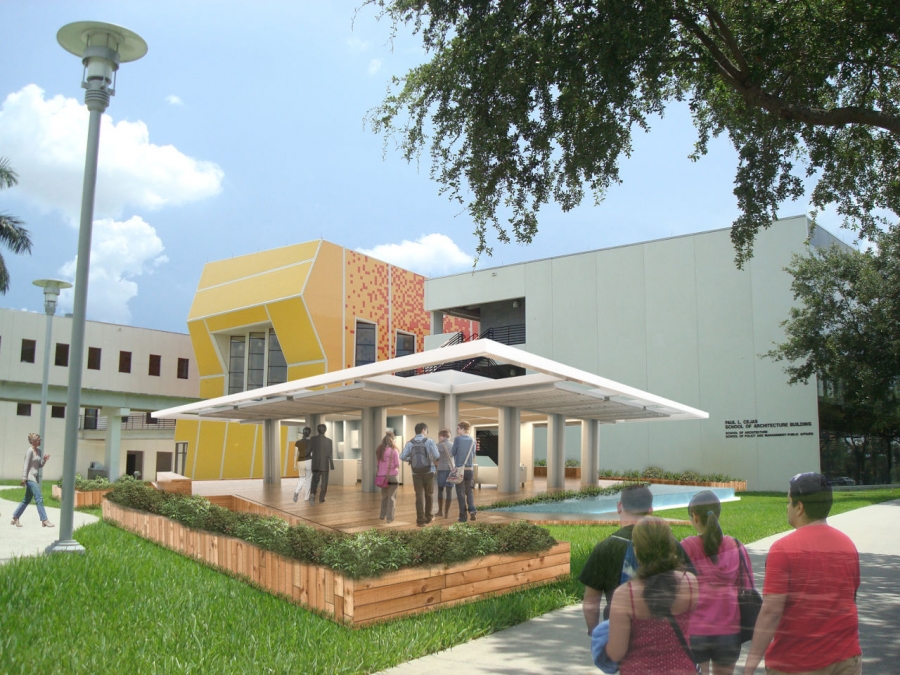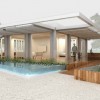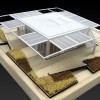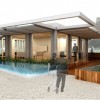2011 Solar Decathlon: Florida International University
Video
perFORM[D]ance House
Teams participating in the 2011 Solar Decathlon strive to create high-tech, low-energy houses, but one team has created a home that also "dances." Florida International University's perFORM[D]ance House features movable facades that allow it to adapt to the needs of its occupants and environmental conditions. This flexible concept fosters connections between indoors and outdoors while mitigating Florida's hot, humid, and hurricane-prone climate.

Florida International University (FIU) originally participated in the Solar Decathlon in 2005 and won first place in the Energy Balance Competition for their Engawa House, named for a Japanese term describing the unity between the interior and exterior of a structure. The 2011 team expanded on this idea, explained Andy Madonna, Team FIU Project Manager and M. Arch. candidate, and they drew inspiration from the vernacular tropical architecture of Central and South America. They also utilized Paul Rudolph’s Walker Guest House in Sarasota, Florida, as a design precedent.
Like Rudolph's iconic design, Team FIU's perFORM[D]ance House is an open pavilion with a layered facade system. It will be constructed with a steel frame and modularized into two structurally independent units so it can be transported to Washington, D.C. Mounted along all sides of the frame will be lightweight yet durable aluminum panels with operable louvers. In the open position, they provide shade and minimize heat gain while admitting indirect natural light and promoting cross ventilation. When bad weather approaches, manual controls allow the panels to slide down and function as hurricane shutters. Although the team initially explored using mechanized controls, in the interest of affordability they designed a manual counterbalance system that exerts a maximum of 5-10 pounds of resistance.
![2011 Solar Decathlon: perFORM[D]ance House | Credit: Florida International University Florida International University's 2011 Solar Decathlon entry perFORM[D]ance House rendering](/images/masterformat/Channels/Go_Green/Solar_D._FIU/2011_Solar_Decathlon_FIU_04.jpg)
![2011 Solar Decathlon: perFORM[D]ance House | Credit: Florida International University Florida International University's 2011 Solar Decathlon entry perFORM[D]ance House rendering](/images/masterformat/Channels/Go_Green/Solar_D._FIU/2011_Solar_Decathlon_FIU_01.jpg)
Behind the louvers, the north facade is lined with double pane bi- and tri-fold glass doors, and the south facade is comprised of prefabricated panels insulated with styrofoam. The interior of the home, which measures 740 sq. ft. (approx. 68 m2), is fully compliant with the Americans with Disabilities Act (ADA-compliant), making it ideal for a retired couple who want to downsize. Students designed a central mechanical core – including storage, systems housing, and a kitchen and bath – to maximize open space along the perimeter, as well as to cut down on the need for extensive wiring, ducts, and plumbing.
The indoor/outdoor connection is further accentuated through the presence of a large wood deck that surrounds the home, establishing continuity with the landscape. The students rotated the deck 15° off the axis of the house's square plan in order to "create unique pockets of interactivity at the corners of the house," according to Madonna. Gardens for herbs and vegetables as well as pools, which provide gray water for biofiltration, are also incorporated into the deck's design.
"Since it's the first time most of us have designed or constructed a functional house, they [the school, professors, and professionals within the community] make sure that what we're doing makes sense in the real world, and we are excited to see how our drawings transform from concept to reality." Andy Madonna, Team FIU
The perFORM[D]ance House relies on roof-mounted photovoltaic arrays to meet its energy needs. Since the roof is flat, the panels will be angled to maximize solar gain, but they can be tilted down in the event of a hurricane. Other sustainable features include solar thermal tubes and rainwater collection. Students coordinated with a LEED consultant to ensure that the design exceeds LEED Platinum standards.
![2011 Solar Decathlon: perFORM[D]ance House | Credit: Florida International University Florida International University's 2011 Solar Decathlon entry perFORM[D]ance House model](/images/masterformat/Channels/Go_Green/Solar_D._FIU/2011_Solar_Decathlon_FIU_03.jpg)
LIke most Solar Decathlon teams, FIU students have benefited from this atmosphere of collaboration. The team is comprised of students and faculty within the Schools of Architecture and the Arts, Engineering, Computer Science, Journalism, and Mass Communications. "The school, professors, and professionals within the community have given us a great deal of assistance," shares Madonna. "Since it's the first time most of us have designed or constructed a functional house, they make sure that what we're doing makes sense in the real world, and we are excited to see how our drawings transform from concept to reality." Following its exhibition on the National Mall, the perFORM[D]ance House will likely return to the FIU campus and serve as headquarters for the newly created Office of Sustainability, serving as an educational tool and showpiece for the school.

Murrye Bernard
Murrye is a freelance writer based in New York City. She holds a Bachelor's degree in Architecture from the University of Arkansas and is a LEED-accredited professional. Her work has been published in Architectural Record, Eco-Structure, and Architectural Lighting, among others. She also serves as a contributing editor for the American Institute of Architects' New York Chapter publication, eOculus.
Website: www.murrye.com




